IRF7
-
Official Full Name
interferon regulatory factor 7 -
Overview
Interferon regulatory factor 7, also known as IRF7, is a member of the interferon regulatory factor family of transcription factors. IRF7 encodes interferon regulatory factor 7, a member of the interferon regulatory transcription factor (IRF) family. IRF7 has been shown to play a role in the transcriptional activation of virus-inducible cellular genes, including the type I interferon genes. In particular, IRF7 regulates many interferon-alpha genes. Constitutive expression of IRF7 is largely restricted to lymphoid tissue, largely plasmacytoid dendritic cells, whereas IRF7 is inducible in many tissues. Multiple IRF7 transcript variants have been identified, although the functional consequences of these have not yet been established. -
Synonyms
IRF7;interferon regulatory factor 7;IRF7A;IRF-7H;OTTHUMP00000162886;IRF-7;OTTHUMP00000162887;OTTHUMP00000229433;OTTHUMP00000229434;interferon regulatory factor-7H
Recombinant Proteins
- Zebrafish
- Rhesus macaque
- Chicken
- Human
- Mouse
- Mammalian Cells
- E.coli
- HEK293
- His
- Non
- Avi
- Fc
- Flag
- DDK
- Myc
Background
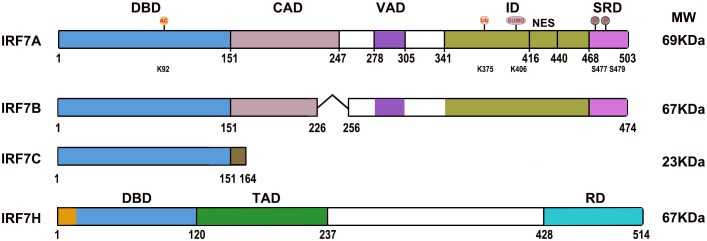
Fig1. Diagrams of the IRF7 isoform domains. (Wei Ma, 2023)
What is IRF7 protein?
IRF7 (interferon regulatory factor 7) gene is a protein coding gene which situated on the short arm of chromosome 11 at locus 11p15. This gene encodes interferon regulatory factor 7, a member of the interferon regulatory transcription factor (IRF) family. It has been shown to play a role in the transcriptional activation of virus-inducible cellular genes, including interferon beta chain genes. Inducible expression of IRF7 is largely restricted to lymphoid tissue. The encoded protein plays an important role in the innate immune response against DNA and RNA viruses. The IRF7 protein is consisted of 503 amino acids and its molecular mass is approximately 54.3 kDa.
What is the function of IRF7 protein?
IRF7 was originally thought to be the primary transcription factor that produces IFN-I and regulates the innate immune response. IRF7 plays a key role in antiviral immunity by triggering a cascade of signals that are activated from pathogen recognition receptors, such as TLRs and RLRs. IRF7 is involved in the production of other cytokines, including IFN-III, which plays a role in antiviral and tumor immunity. The activity and stability of IRF7 are epigenetic regulated, such as through methylation affecting gene expression.
IRF7 Related Signaling Pathway
IRF7 is a major transcription factor that produces IFN-I. By binding with IFN-stimulating gene factor 3 (ISGF3), IRF7 activates the production of IFN-I, thereby regulating the antiviral immune response. IRF7 is involved in pathogen recognition and immune response by interacting with Toll-like receptors (TLRs) mediated signaling pathways, particularly through TLR3, TLR7, TLR9, and possibly DNA-dependent activators (DDA) and IFI16. IRF7 interacts with the NF-κB signaling pathway, co-regulating the expression of target genes in inflammatory and immune responses. After IRF7 activation, JAK-STAT signaling pathway can be triggered, especially through IFN-I production and signaling, activation of JAK1 and TYK2, and activation of STAT1 and STAT2.TBK1 (tank-bound kinase 1) and IKK (IκB kinase ε) are two key kinases. It is involved in the phosphorylation and activation of IRF7, which promotes the production of IFN-I.
IRF7 Related Diseases
IRF7 plays a key role in the antiviral response, as it is involved in regulating the production of type I interferon (IFN-I), which is essential for defending against viral infection. The expression of RF7 is associated with the pathogenesis of SSc, and it may be involved in skin and internal organ fibrosis through interaction with TGF-β signaling pathway. The role of IRF7 in AIP includes mediating the production of IFN-I and IL-33, which may be related to the chronic inflammatory response of the disease. IRF7 may play a role in the pathogenesis of type 1 diabetes (T1D), it is involved in the development of the disease by affecting the function of Treg cells and the autoimmune response of beta cells, the role of IRF7 in type 2 diabetes may be related to inflammation and insulin resistance, it may be involved in the development of the disease by affecting the expression of MCP-1. IRF7 has been implicated in the development of psoriasis and in response to treatment, and it may play a role in the inflammatory process of the disease.
Bioapplications of IRF7
The IRF7 protein could be used to develop new antiviral drugs. By enhancing or mimicking the function of IRF7, it can help the body fight viral infections such as influenza, HIV, and hepatitis B more effectively. The IRF7 protein could be used to develop more effective vaccines. By enhancing the IRF7 response, the immune response triggered by the vaccine can be enhanced, thus improving the effectiveness of the vaccine. IRF7 plays a key role in regulating the immune response, so by regulating the activity of IRF7, it may help treat some autoimmune diseases, such as rheumatoid arthritis and lupus.
Case Study
Case Study 1: Fumie Ohtani, 2021
Viral infections of the cornea including herpes simplex virus 1 (HSV-1) cause visual morbidity, and the corneal endothelial cell damage leads to significant visual impairment. Interferon regulatory factor 7 (IRF7) has been identified as a significant regulator in corneal endothelial cells after an HSV-1 infection. To examine the role played by IRF7, the DNA binding domain (DBD) of IRF7 of human corneal endothelial cells (HCEn) was disrupted. An RNAi inhibition of IRF7 and IRF7 DBD disruption (IRF7 ∆DBD) led to an impairment of IFN-β production. Impaired IFN-β production by IRF7 ∆DBD was regained by IRF7 DNA transfection. Transcriptional network analysis indicated that IRF7 plays a role in antigen presentation function of corneal endothelial cells. When the antigen presentation activity of HCEn cells were examined for priming of memory CD8 T cells, IRF7 disruption abolished the anti-viral cytotoxic T lymphocyte (CTL) response which was dependent on the major histocompatibility complex (MHC) class I. To further examine the roles played by IRF7 in CTL induction as acquired immunity, the contribution of IRF7 to MHC class I-mediated antigen presentation was assessed. Analysis of IRF7 ∆DBD cells indicated that IRF7 played an unrecognized role in MHC class I induction, and the viral infection induced-MHC class I induction was abolished by IRF7 disruption.
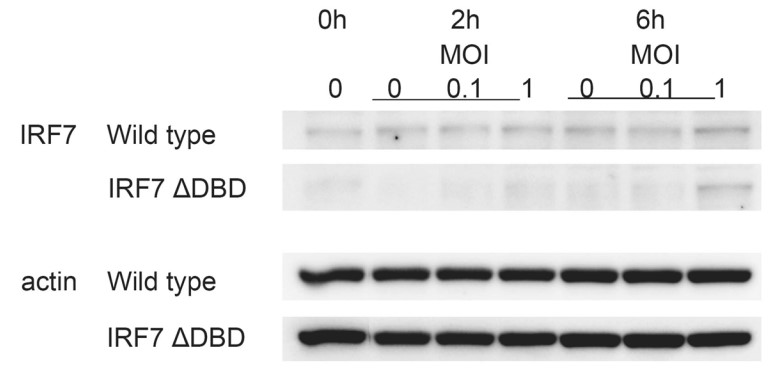
Fig1. Induction of IRF7 protein after HSV-1 infection was determined by Western blot.
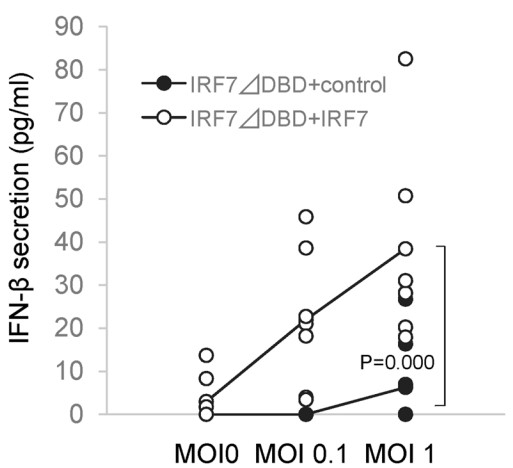
Fig2. The impaired IFN-β secretion in IRF7 ∆DBD HCEn cells is restored.
Case Study 2: Yang Zhao, 2017
The purpose of this study was to identify the role of interferon regulatory factor 7 (IRF7) in the bone metastasis of prostate cancer. Herein the researchers demonstrated the lower expression of IRF7 in bone metastases of prostate cancer. Overexpression of IRF7 in prostate cancer cells had a marked effect on inhibiting bone metastases but not on tumor growth in xenograft nude mice. While in vitro, upregulation of IRF7 had little effect on the malignant phenotype of prostate cancer cells including proliferation, apoptosis, migration, and invasion. However, prostate cancer cells overexpressing IRF7 significantly enhanced the activity of NK cells, which resulted in the cytolysis of prostate cancer target cells. The underlying mechanism may be relevant to the increasing expression of IFN-β induced by IRF7, as the downregulation of which could inversely inhibit the activity of NK cells.
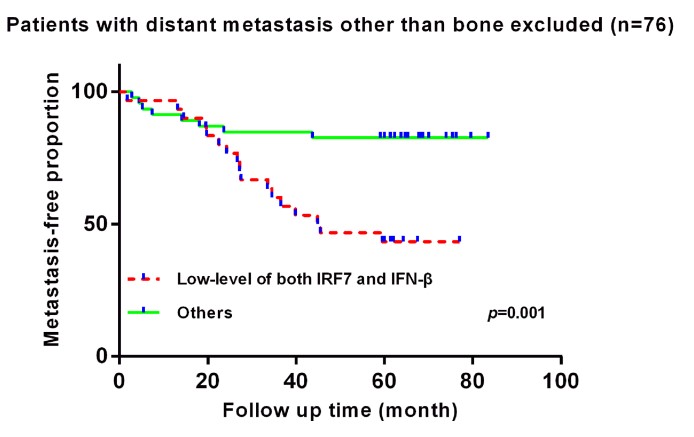
Fig3. Kaplan–Meier analysis of a low level of both IRF7 and IFN-β in primary prostate cancer.
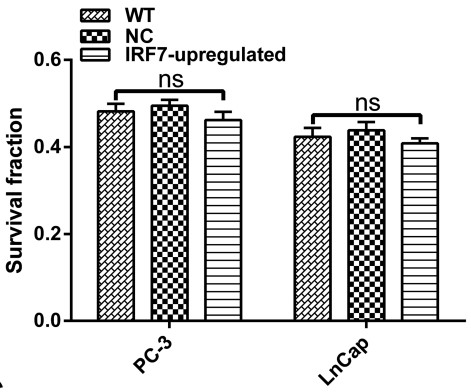
Fig4. The colony formation assay of prostate cancer cells.
Quality Guarantee
High Purity
.jpg)
Fig1. SDS-PAGE (IRF7-897H)
Involved Pathway
IRF7 involved in several pathways and played different roles in them. We selected most pathways IRF7 participated on our site, such as Toll-like receptor signaling pathway,RIG-I-like receptor signaling pathway,Cytosolic DNA-sensing pathway, which may be useful for your reference. Also, other proteins which involved in the same pathway with IRF7 were listed below. Creative BioMart supplied nearly all the proteins listed, you can search them on our site.
| Pathway Name | Pathway Related Protein |
|---|---|
| RIG-I-like receptor signaling pathway | PIN1,AZI2,OTUD5,IL-8,Ifna11,FADD,RNF125,IFNA10,IL8L2,NFKBIAA |
| Hepatitis B | CCND1,CXCL8,TNF,HRAS,BAD,CYCS,MAPK10,RAF1,NFATC3,PRKCA |
| Cytosolic DNA-sensing pathway | IL33,RIPK3,IFNA16,POLR2E,IL18,NFKBIB,NFKBIAB,AIM2,IRF3,POLR3H |
| Viral carcinogenesis | PIK3R5,RBL2,YWHAB,PIK3CD,TBPL2,STAT5A,VDAC3,CDC42,HDAC11,HDAC10 |
| Toll-like receptor signaling pathway | RAC1,CCL3,MAP2K3,IFNA5,CCL4,IKBKE,MAPK10,IL12BA,TLR2,MAPK12B |
| Hepatitis C | EIF2AK3,IFNA6,MAPK9,IFNB1,EIF2AK1,CLDN5,CLDN15,PPP2R2B,OCLN,MAVS |
| Influenza A | HLA-DPB1,TLR3,MAPK11,IFNGR1,TNF,ADAR,PRSS3,IFNG,PRSS2,RAE1 |
| Herpes simplex infection | RNASEL,TAF6,ARNTL,HLA-DQA1,CD74,TRP53,IFNA17,SFRS3B,USP7,RELA |
| Measles | FCGR2B,TP73,STAT1,CD209A,Cd209g,TYK2,PIK3R1,HSPA8,RAB9B,FASLG |
Protein Function
IRF7 has several biochemical functions, for example, DNA binding,RNA polymerase II core promoter sequence-specific DNA binding,protein binding. Some of the functions are cooperated with other proteins, some of the functions could acted by IRF7 itself. We selected most functions IRF7 had, and list some proteins which have the same functions with IRF7. You can find most of the proteins on our site.
| Function | Related Protein |
|---|---|
| transcription factor activity, RNA polymerase II core promoter proximal region sequence-specific binding | SREBF1,RBPJL,HIST2H3A,SFPI1,SNAI3,FOSL1,FOSL2,CLOCK,ATF3,TFAP2A |
| RNA polymerase II core promoter sequence-specific DNA binding | HEYL,SP1,TBR1,RUVBL2,SOX3,RREB1,TFAP2B,STAT6,TAL1,SMAD5 |
| DNA binding | MSXC,OTX1B,NAT14,POLM,CENPW,ZNF544,ARNTL1A,HIST1H2AE,CLOCKA,FOXO1A |
| protein binding | TLR3,MEF2C,IL6ST,MPL,MB21D2,ADAMTS10,TRIM44,BEX5,KRT2,FBXL12 |
Interacting Protein
IRF7 has direct interactions with proteins and molecules. Those interactions were detected by several methods such as yeast two hybrid, co-IP, pull-down and so on. We selected proteins and molecules interacted with IRF7 here. Most of them are supplied by our site. Hope this information will be useful for your research of IRF7.
BICP0;ORF45;TBK1;AIP;LTN1;ARAF;IRAK1;TLK2
Resources
Related Services
Related Products
References
- Audet, J; Kobinger, GP; et al. Immune Evasion in Ebolavirus Infections. VIRAL IMMUNOLOGY 28:10-18(2015).
- Thackray, LB; Shrestha, B; et al. Interferon Regulatory Factor 5-Dependent Immune Responses in the Draining Lymph Node Protect against West Nile Virus Infection. JOURNAL OF VIROLOGY 88:11007-11021(2014).


